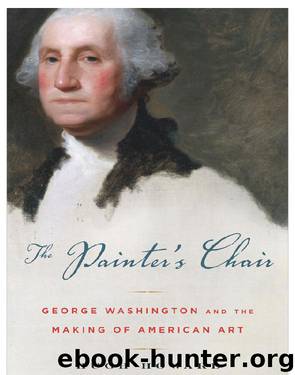The Painter's Chair by Hugh Howard

Author:Hugh Howard
Language: eng
Format: epub
Publisher: Bloomsbury Publishing Plc
Published: 2000-01-01T05:00:00+00:00
III.
1791-1793 . . . London
EDWARD SAVAGE MOVED to London to advance his new craft. Like other aspiring American artists, he sought out Benjamin West, who had just been elevated to the presidency of the Royal Academy. In that foreign capital, Savage thought he could master the profitable art of engraving. When he arrived, his skills were no more than rudimentary, but by early 1792 he was able to publish a good-quality stipple engraving based upon the George Washington he had painted for Harvard College. The General looked his age (Washington turned sixty just as the print was issued), with a somber dignity.
Savage continued his painting, making a variant portrait of Washington, this one portraying the Virginian as a statesman rather than a soldier. The uniform has vanished; instead, Washington wears a black velvet coat, with wrist ruffles and a lace jabot at the neck. In this three-quarter view, he is seated at a table and holds in his hands a document distinguishable as the plan for the new Federal City (though the man himself would always have difficulty bringing himself to call it “Washington,” the new capital had recently been given that name). Savage published this portrait, too, as a print, extending his artistic reach once more by engraving the image as a mezzotint. But its significance would prove to be as a stage in the development of a much bigger painting.
Prior to leaving New York two years earlier, Savage had begun work on an easily portable oil study—it was eighteen and a half inches high by twenty-four inches wide—of a very different picture. This was the Washington family group, which, he later told Washington, he had also begun transferring to a copper plate. The image was still taking shape in his mind, and, during his London days, Savage kept the canvas and the copper plate near at hand. At odd moments he returned to them, altering the figure of Washington to coincide with the three-quarters portrait. He incorporated the map of the Federal City, and the mezzotint of Washington and the canvas also came to share the same backdrop. He added the base of a Doric column and a bulky swagged curtain to the work in progress. During his stay in London, Savage added a fifth figure, too, a slave in livery standing at the periphery of the family group. For a model he used the black manservant of the American minister to the Court of St. James’s.
This project—Savage called it The Washington Family—became the one on which he placed his greatest expectations. His hopes for The Washington Family grew as he observed the newest currents in the London art world. He was learning about more than engraving, taking careful note of the fashion for mounting an exhibition that consisted of a single large work, usually a history painting, which portrayed a contemporary hero. One of the most successful practitioners of the painting show was Savage’s émigré countryman, John Singleton Copley, who had taken to installing his newest large-scale painting in a grand frame that resembled the proscenium arch of a theater.
Download
This site does not store any files on its server. We only index and link to content provided by other sites. Please contact the content providers to delete copyright contents if any and email us, we'll remove relevant links or contents immediately.
| Africa | Americas |
| Arctic & Antarctica | Asia |
| Australia & Oceania | Europe |
| Middle East | Russia |
| United States | World |
| Ancient Civilizations | Military |
| Historical Study & Educational Resources |
Cat's cradle by Kurt Vonnegut(15149)
Pimp by Iceberg Slim(14313)
4 3 2 1: A Novel by Paul Auster(12261)
Underground: A Human History of the Worlds Beneath Our Feet by Will Hunt(11996)
The Radium Girls by Kate Moore(11897)
Wiseguy by Nicholas Pileggi(5642)
Perfect Rhythm by Jae(5302)
American History Stories, Volume III (Yesterday's Classics) by Pratt Mara L(5238)
The Fire Next Time by James Baldwin(5221)
Paper Towns by Green John(5061)
Pale Blue Dot by Carl Sagan(4883)
A Higher Loyalty: Truth, Lies, and Leadership by James Comey(4820)
The Mayflower and the Pilgrims' New World by Nathaniel Philbrick(4402)
The Doomsday Machine by Daniel Ellsberg(4395)
Killers of the Flower Moon: The Osage Murders and the Birth of the FBI by David Grann(4367)
The Sympathizer by Viet Thanh Nguyen(4286)
Too Much and Not the Mood by Durga Chew-Bose(4253)
The Borden Murders by Sarah Miller(4214)
Sticky Fingers by Joe Hagan(4083)
